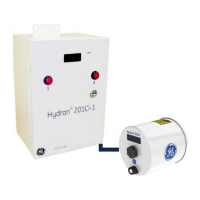10.2 Communications in a Network, using an RS-485 Local
Network Link and Hydran 201Ci controllers
Up to 128 Hydran 201Ti Intelligent Transmitters can be connected in a single network
to be monitored and controlled by computer. Once the H201Tis are connected to a
Hydran 201Ci-C or Hydran 201Ci-1 Controller via an isolated supervisory link, each
Hydran 201Ci Controller is linked to the next H201Ci in a daisy- chain configuration via
an isolated RS-485 LAN. An example of local network is shown in Figure 10-1 below.
Any H201Ci in the network can then be linked to the host computer (see Section 10.3).
Each H201Ti can communicate with the host computer because each H201Ti is identified
by a specific address (a number from 1 to 254) set by the user.
Note the following points:
• The total length of all RS-485 link cables in a single network must not exceed
1,200m (4,000ft). This corresponds to an average length of 40m (120ft) for a
local network containing 32 H201Cis.
• The RS-485 LAN uses an isolated, three-wire, shielded cable which is protected
to withstand the large noise transients typically found in electrical
substations.
• The H201Cis manage all communications automatically (transmission and
reception). Data transmission is half-duplex (one direction at a time, from a
single talker).
• Ideally, the H201Ci’s should be located in a limited zone of an electrical
substation, for example the control room.
The RS-485 local network link cable can be connected at the following locations:
• In the H201Ci-C: To the terminals 21 to 24 of the Main Terminal Block (item 5 in
Figure 4-2).
• In the H201Ci-1: To the terminals 21 to 24 of the Main Terminal Block (item 6 in
Figure 4-6).
The installation of an RS-485 local network link cable is described in Section 10.5.1.

